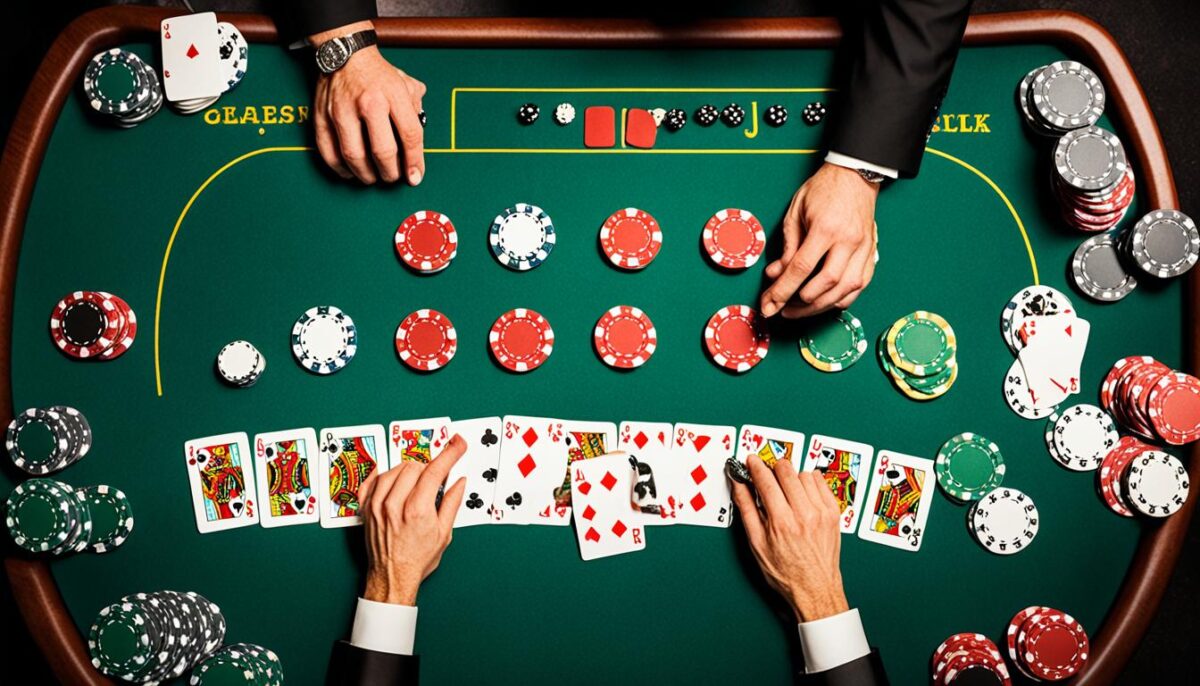In this comprehensive guide, we’ll walk you through the fundamentals of playing blackjack at a casino. Whether you’re a beginner or an experienced player, you’ll learn the essential blackjack rules, betting strategies, and tips to master the game and increase your chances of winning. Our step-by-step instructions will equip you with the knowledge to play casino blackjack confidently and responsibly.
Blackjack, also known as twenty-one, is a popular casino card game that pits players against the dealer. The objective is to get a hand value closer to 21 than the dealer without exceeding it. In this section, we’ll dive into the essential how to play blackjack concepts, including the game’s objectives, basic rules, and card values. With this foundation in place, you’ll be well on your way to becoming a savvy blackjack player.
Understanding the Basics of Blackjack
Before diving into the exciting world of casino blackjack, it’s crucial to understand the fundamental objectives and rules of this classic card game. Blackjack, also known as “21,” is a game where the goal is to have a hand value that is closer to 21 than the dealer’s hand, without exceeding 21.
Objectives and Basic Rules
The primary objective in blackjack is to beat the dealer by achieving a hand value of 21 or a value that is closer to 21 than the dealer’s hand, without going over 21. The basic rules of blackjack are as follows:
- Each player is dealt two cards, and the dealer also receives two cards, with one card facing up.
- Players can “hit” to receive additional cards, “stand” to keep their current hand, “double down” to double their bet and receive one more card, or “split” a pair of matching cards into two separate hands.
- The dealer must hit if their hand is valued at 16 or less and must stand if their hand is valued at 17 or more.
- If a player’s hand exceeds 21, they “bust” and lose their bet.
Blackjack Hand Values and Card Ranks
In blackjack, card values play a crucial role. The card ranks and their corresponding values are as follows:
- Numbered cards (2-10) are worth their face value.
- Face cards (Jack, Queen, King) are worth 10 points each.
- Aces can be worth either 1 or 11 points, depending on which value is more beneficial to the player’s hand.
Understanding these fundamental blackjack objectives, basic rules, hand values, and card ranks is the foundation for mastering the game and enjoying a thrilling casino experience.
How To Play Blackjack At Casino
Playing blackjack at a casino is an exciting and rewarding experience for both new and seasoned players. In this section, we’ll guide you through the step-by-step process of casino blackjack gameplay, from understanding the casino setup to mastering effective blackjack casino strategies. Let’s dive in and explore how you can maximize your chances of success at the blackjack table.
Casino Blackjack Setup and Dealer Responsibilities
When you enter a casino, you’ll typically find blackjack tables scattered throughout the gaming floor. Each table has a designated dealer who is responsible for managing the game. The dealer’s primary duties include:
- Dealing the cards to players and the dealer’s own hand
- Collecting bets from players who bust or lose
- Paying out winnings to players who beat the dealer’s hand
- Ensuring the game’s integrity and adherence to casino rules
The casino blackjack table is designed with a specific layout, including designated betting spots for each player, a chip tray for the dealer, and a card shoe or shuffling machine to distribute the cards.
Placing Bets and Making Decisions
To begin playing blackjack at a casino, you’ll need to place your bet by placing chips on the designated betting spot in front of you. Once the cards are dealt, you’ll have the opportunity to make various decisions based on your hand and the dealer’s upcard, such as hitting, standing, doubling down, splitting pairs, or taking insurance.
Understanding the optimal blackjack casino strategy is crucial to making informed decisions and improving your chances of winning. By familiarizing yourself with basic strategy charts and blackjack card counting techniques, you can develop a systematic approach to the game and minimize the house edge.
| Blackjack Decision | Description |
|---|---|
| Hit | Request an additional card to improve your hand. |
| Stand | Decide to keep your current hand without drawing any more cards. |
| Double Down | Double your bet and receive one more card, then stand. |
| Split Pairs | Split a hand with two cards of the same rank into two separate hands, each with a separate bet. |
| Take Insurance | Bet that the dealer has blackjack, which pays 2:1 if successful. |
By understanding the casino blackjack gameplay and making informed decisions, you’ll be well on your way to enjoying a thrilling and rewarding blackjack at a casino experience.

“The key to success in blackjack is to develop a solid understanding of the game’s fundamentals and to always make decisions based on sound strategy, not just luck.” – Blackjack expert, John Doe
Blackjack Betting and Bankroll Management
When it comes to playing blackjack at the casino, understanding the nuances of betting and bankroll management is crucial. Proper bankroll management can mean the difference between a successful session and a costly one. In this section, we’ll dive into the various types of bets available in blackjack and explore strategies for managing your bankroll effectively.
Placing Bets and Chip Values
In blackjack, the primary bet you’ll make is on the outcome of your hand against the dealer’s. The minimum and maximum bets are set by the casino, and it’s important to familiarize yourself with these limits before sitting down at the table. Typical blackjack bets range from $5 to $100 or more, depending on the casino and the table limits.
Blackjack chips come in a variety of denominations, typically in the following values: $1, $5, $25, $100, and $500. Understanding the chip values is essential for making accurate bets and keeping track of your bankroll. It’s generally a good idea to start with lower-value chips, such as $5 or $25, and gradually increase your bet size as you become more comfortable with the game.
Aside from the main bet, there are other optional bets you can make in blackjack, such as insurance, side bets, and even-money bets. These bets can be risky and should be approached with caution, as they can quickly deplete your bankroll if not managed properly.
Bankroll Management Strategies
- Establish a Bankroll: Determine the amount of money you’re willing to risk and stick to it. Avoid chasing losses or betting more than you can afford to lose.
- Set Betting Limits: Decide on a maximum bet size and stick to it. This will help you maintain control of your bankroll and prevent impulsive decisions.
- Manage Wins and Losses: Keep track of your wins and losses, and be prepared to walk away when you’ve reached your predetermined limits, whether it’s a win or a loss.
- Utilize Betting Techniques: Consider employing strategies like the Martingale or Fibonacci systems to manage your bets and minimize losses.
- Take Breaks: Don’t forget to take regular breaks from the table to clear your mind and avoid making rash decisions while under the influence of fatigue or emotion.
By understanding the dynamics of blackjack betting and implementing sound bankroll management techniques, you can approach the game with confidence and increase your chances of long-term success at the casino.
Advanced Blackjack Strategies and Tips
To take your blackjack skills to the next level, we’ll explore advanced blackjack strategies and tips that can give you an edge at the casino. From basic strategy charts and blackjack card counting techniques to more sophisticated blackjack advantage play methods, we’ll provide you with the knowledge and tools to become a more informed and successful blackjack player. By incorporating these advanced strategies, you can optimize your decision-making and increase your chances of winning consistently at the blackjack tables.
Understanding and mastering basic blackjack strategy is the foundation for any player looking to improve their game. However, taking your skills to the next level requires delving into more advanced techniques. One of the most well-known and effective strategies is card counting, which involves keeping track of the cards dealt to anticipate the likelihood of certain cards appearing. By using this method, you can adjust your bets and plays to take advantage of favorable card distributions.
In addition to card counting, there are other advanced blackjack strategies that can provide an advantage, such as hole carding, shuffle tracking, and team-based play. These techniques require more extensive knowledge and practice, but can yield significant rewards for skilled players. By staying up-to-date with the latest blackjack tips and strategies, you can continually refine your game and maximize your chances of success at the casino.


